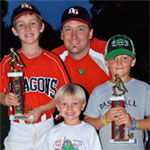Hitting Guidelines - Set-up

Your stance sets the tone for your whole swing. A proper set-up puts your body in a strong position, every time. Take your time to get it right. If it takes you a few extra seconds to get it right, then take the time. It can make a huge difference in your swing.
1. Select a bat
How: Selecting a bat can be done using several different methods, but understand this: Swing a bat that you can handle. Swing several different lengths and weights to determine which feels best and if possible, have someone watch you swing it. You might think it feels great, but an observer might have a different take on it. Too light, too short, too long, or too heavy can each pose separate problems.
Troubleshooting: Bat manufacturers have done an excellent job making bats that each age group can handle. Ideally, stay within your prescribed ranges: -12, -8, -5 or -3. The majority of problems occur when the hitter chooses a bat that is too heavy and is out of the range for his/her age group. Things to look for with heavy bat: Excessive dropping of the hands and/or barrel, really slow bat speed, swinging with both arms straight, off balance swing/follow through due to the weight of the bat.
2.Get your grip
How: There are several different ideas on how to grip the bat, comfort is going to be the key. The strongest part of your hand is at the base of the fingers along the pads of the knuckles and will also give you the largest range of motion with your top hand. An easy way to figure out a good grip, lay the bat across the bottom section of the fingers on both hands and close fingers around bat. Grip should be firm, not too tight, not too loose.
Troubleshooting: An improper grip may limit what your hands and arms are able to do. What to look for: A top hand that is over-rotated toward the inside with the palm facing more toward body.
3. Feet a little wider than shoulder width apart, parallel and in line with the pitcher
Why: Stride length is very important which is why a proper starting point is so crucial. Feet need to spread an optimum distance to fully utilize the hips and keep the bat head in the hitting zone the longest. The narrower the stance, the longer the stride to optimum toe touch. The longer the stride the more precise the timing needs to be to be an effective hitter. This can also lead to lunging at the pitch. The narrower the stance with a shorter stride will under-utilize the hips and cause the bat head to stay in the hitting zone a shorter period of time. This can also lead to getting too far out on your front foot, locking up the hips and being susceptible to the off-speed pitch. The wider the stance the shorter the stride and you run the risk of not getting a good weight shift from back to front. If you end up too spread out, this can also lead to not getting a full hip turn, again, under-utilizing the hips.
Keep the feet parallel and in line with the pitcher because we want to create a nice straight path for the stride to take place back toward the pitcher.
Troubleshooting: Alignment is the key here and is an easy fix. Simply look down and check your feet.
4. Both toes pointing straight ahead (toward other batter’s box)
Why: With your back toe pointing straight ahead, your back hip is now in a strong position to get a full turn. With your front toe pointing straight ahead, your hips are closed allowing you to explode the hips at the start of your swing.
5. Weight evenly distributed between legs or slightly back
Why: We want our body in a position to load our weight back before we start our swing. If the weight is primarily on the back foot in the stance, we will not get much of a weight shift back and will have a tendency to stride with all our weight which can cause lunging at the pitch. The opposite side of that is when we start with all our weight back and do not shift during the swing at all. Balance is always the key.
Troubleshooting: Weight should be on the balls of each big toe, almost like your stepping on two paper towels and trying tear them down the middle. This puts us in an athletic position to go either way, rock back and go forward. Watch for excessive weight on the back foot.
6. Slight bend at knees, waist
Why: In keeping with our weight on the balls of our feet, we want to be an in athletic posture with our body. Also, we want to be able to handle as many pitches as possible while keeping our body and head in a strong hitting position. The slight bend in the knees and waist accomplishes this. Too upright in your stance and you will be able to the hit high pitch best. Too crouched in your stance and you will be able to hit the low pitch best.
Find the middle ground because the head is the key. We want to keep our head as still as possible. From an upright stance, we are forced to bend either at the waist or the knees or both to reach the low pitch, causing our head to move downward and distorting the ball flight. From a crouched stance, we are forced to come up to hit the high pitch, subsequently moving our head higher and again distorting our perception of the ball flight.
7. Both eyes on the pitcher, head up
Why: Two eyes are better than one. Everyone has a more dominant eye, use both. Easy tip: Cover front eye with your hand. If you can see the pitcher fully with your rear eye, your head is in a good starting spot. The more upright your head, the better view of the pitch you will have.
Troubleshooting: Watch for excessive head tilt over the plate.
8. Bat angle at 45 degrees
Why: Again, we want to put our bat in a position to hit as many pitches as well as possible. A flatter bat will be more effective on the high pitch because it is already on a flatter plane. A more upright bat will be more effective on the low pitch because it is already on a steeper plane. Your bat at a 45-degree angle is already on the perfect plane and allows you to hit both the high pitch and the low pitch equally effectively.
9. Hands in comfortable position near back shoulder
Why: During the load portion of the swing (as we will discuss later), we want our hands to be going back. We want movement in the hands, but not excessive movement. Again, any excessive movement can cause timing problems. The closer we are to the launching zone (where we start our hands), the better.
Troubleshooting: Hand positioning is extremely important and one of the most corrected faults of young hitters. Ensure the hands are at or near the back shoulder.
10. Elbows flexed/arms relaxed
Why: We want to keep our arms flexed so we can extend through the pitch. We also want to keep our arms relaxed because we do not want to create any tension. Tension will rob you of bat speed.
The last point to make is that of the back elbow. Very few successful hitters can start with one or more of their body parts in an extreme position. That being said, it’s not where you start, but where you finish. Get that back elbow in a neutral position, not too high, not too low.
This is part one of a three part article
Click here to read part two: Stride/Load
Click here to read part three: The Swing
For more information, check out:
The Hitting Stance Video
"Pitch" © 2013 Iaffy4k, used under a Creative Commons Attribution-ShareAlike license: http://

